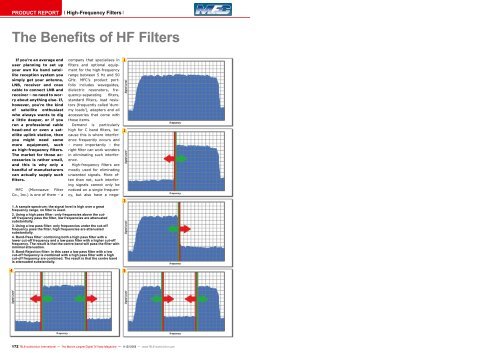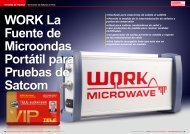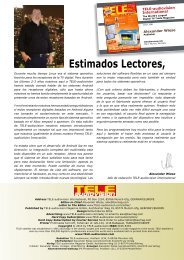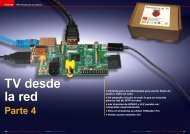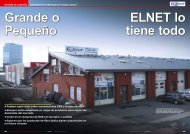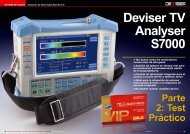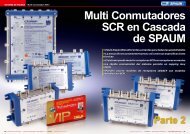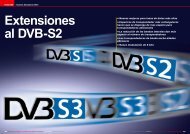Filtros Hechos por MFC
You also want an ePaper? Increase the reach of your titles
YUMPU automatically turns print PDFs into web optimized ePapers that Google loves.
PRODUCT REPORT<br />
High-Frequency Filters<br />
The Benefits of HF Filters<br />
If you’re an average end<br />
user planning to set up<br />
your own Ku band satellite<br />
reception system you<br />
simply get your antenna,<br />
LNB, receiver and coax<br />
cable to connect LNB and<br />
receiver – no need to worry<br />
about anything else. If,<br />
however, you’re the kind<br />
of satellite enthusiast<br />
who always wants to dig<br />
a little deeper, or if you<br />
run a professional cable<br />
head-end or even a satellite<br />
uplink station, then<br />
you might need some<br />
more equipment, such<br />
as high-frequency filters.<br />
The market for those accessories<br />
is rather small,<br />
and this is why only a<br />
handful of manufacturers<br />
can actually supply such<br />
filters.<br />
<strong>MFC</strong> (Microwave Filter<br />
Co., Inc.) is one of them – a<br />
4<br />
company that specialises in<br />
filters and optional equipment<br />
for the high-frequency<br />
range between 5 Hz and 50<br />
GHz. <strong>MFC</strong>’s product <strong>por</strong>tfolio<br />
includes waveguides,<br />
dielectric resonators, frequency-separating<br />
filters,<br />
standard filters, load resistors<br />
(frequently called ‘dummy<br />
loads’), adapters and all<br />
accessories that come with<br />
those items.<br />
Demand is particularly<br />
high for C band filters, because<br />
this is where interference<br />
frequently occurs and<br />
– more im<strong>por</strong>tantly – the<br />
right filter can work wonders<br />
in eliminating such interference.<br />
High-frequency filters are<br />
mostly used for eliminating<br />
unwanted signals. More often<br />
than not, such interfering<br />
signals cannot only be<br />
noticed on a single frequency,<br />
but also have a nega-<br />
1. A sample spectrum: the signal level is high over a great<br />
frequency range, no filter is used.<br />
2. Using a high pass filter: only frequencies above the cutoff<br />
frequency pass the filter, low frequencies are attenuated<br />
substantially.<br />
3. Using a low pass filter: only frequencies under the cut-off<br />
frequency pass the filter, high frequencies are attenuated<br />
substantially.<br />
4. Band-Pass filter: combining both a high pass filter with a<br />
lower cut-off frequency and a low pass filter with a higher cut-off<br />
frequency. The result is that the centre band will pass the filter with<br />
minimal attenuation.<br />
5. Band-Rejection filter: in this case a low pass filter with a low<br />
cut-off frequency is combined with a high pass filter with a high<br />
cut-off frequency are combined. The result is that the centre band<br />
is attenuated substantially.<br />
1<br />
2<br />
3<br />
5<br />
172 TELE-audiovision International — The World‘s Largest Digital TV Trade Magazine — 11-12/2013 — www.TELE-audiovision.com


